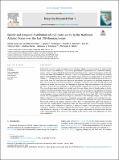Files in this item
Spatial and temporal distribution of cold-water corals in the Northeast Atlantic Ocean over the last 150 thousand years
Item metadata
| dc.contributor.author | Ferreira, Maria Luiza de Carvalho | |
| dc.contributor.author | Robinson, Laura F. | |
| dc.contributor.author | Stewart, Joseph A. | |
| dc.contributor.author | Li, Tao | |
| dc.contributor.author | Chen, Tianyu | |
| dc.contributor.author | Burke, Andrea | |
| dc.contributor.author | Kitahara, Marcelo | |
| dc.contributor.author | White, Nicholas J. | |
| dc.date.accessioned | 2022-12-05T17:30:03Z | |
| dc.date.available | 2022-12-05T17:30:03Z | |
| dc.date.issued | 2022-12 | |
| dc.identifier | 281674962 | |
| dc.identifier | a735c6f8-35cb-4ff0-882c-df20225aee40 | |
| dc.identifier | 85140313853 | |
| dc.identifier.citation | Ferreira , M L D C , Robinson , L F , Stewart , J A , Li , T , Chen , T , Burke , A , Kitahara , M & White , N J 2022 , ' Spatial and temporal distribution of cold-water corals in the Northeast Atlantic Ocean over the last 150 thousand years ' , Deep Sea Research Part I: Oceanographic Research Papers , vol. 190 , 103892 . https://doi.org/10.1016/j.dsr.2022.103892 | en |
| dc.identifier.issn | 0967-0637 | |
| dc.identifier.other | ORCID: /0000-0002-3754-1498/work/121753921 | |
| dc.identifier.uri | https://hdl.handle.net/10023/26545 | |
| dc.description | Authors acknowledge the crew and researchers on board the research cruises JC142 (Tropic Seamount in 2016; project ‘MarineE-tech’; grants NE/M011186/1, awarded to B. Murton and NE/M011151/1, awarded to P. Lusty), JC094 (Equatorial Atlantic in 2013) and CE08-06 (Reykjanes Ridge in 2008) who obtained the samples for this study. We thank Christopher Coath, Carolyn Taylor and Yun-Ju Sun for their help with laboratory work. We thank the editors, Sophia Hines, and two other reviewers for their comments which considerably improved this manuscript. Funding was provided by NERC grants awarded to L.F.R. (NE/S001743/1 and NE/R005117/1) and by Schlumberger Foundation who provided the PhD scholarship “Faculty for the Future Fellowship”. M.V.K. acknowledges the support from the São Paulo Research Foundation (FAPESP #2017/50229-5) and from the National Council for Scientific and Technological Development (CNPq #301436/2018-5). | en |
| dc.description.abstract | Scleractinian cold-water corals are found across the Northeast Atlantic, providing structure for important habitats that support high biodiversity. Climate-driven perturbations on parameters such as carbonate chemistry, oxygen, bottom currents, productivity and temperature have the potential to impact the abundance and diversity of these cold-water coral communities. One way to explore the linkage between corals and climate is to examine historic coral distributions during times of past climate change. Previous coral dating efforts in the Northeast Atlantic (n ∼ 700) have focused on reef-forming colonial coral communities from shelf and slope areas. However, there are far fewer data from open-ocean settings or from solitary coral species, thus precluding assessment of basin-wide controls on coral occurrence. Here, we contribute >600 new U-series ages for both solitary and colonial coral species from open-ocean sites including the Reykjanes Ridge and seamounts in the mid and low latitudes to map the changing distribution of Northeast Atlantic cold-water corals over the last 150,000 years. The temporal occurrences of solitary and colonial corals from our offshore sites are broadly similar to the distributions along the nearer-shore sites at the same latitudes. In the cold-temperate and high-latitude Northeast Atlantic, corals are most abundant during warm climate intervals, with the Reykjanes Ridge (60°N) representing the northernmost limit of corals in the Northeast Atlantic during Marine Isotope Stage (MIS) 5, MIS 3 and Bølling-Allerød. This biogeographical distribution expanded northwards to the Norwegian margin at the onset of the Holocene when the ice sheets retreated and modern-like oceanographic conditions were established. We interpret the abundance of corals at these northerly sites to be linked with increased food supply and favourable hydrological conditions. By contrast, coral sites south of 45°N are characterised by glacial and deglacial occurrences, with a marked decline during the Holocene. This distribution is also linked to food supply, potentially driven by shifts in dust fertilization and upwelling, in addition to changes in dissolved oxygen concentration and temperature. Together, these findings emphasize the links between climate, oceanic processes, and cold-water coral distribution, pointing to low food supply and low oxygen concentration as limiting factors for cold-water coral populations. Both parameters are changing in the modern ocean, with implications for future coral communities. | |
| dc.format.extent | 14 | |
| dc.format.extent | 7927647 | |
| dc.language.iso | eng | |
| dc.relation.ispartof | Deep Sea Research Part I: Oceanographic Research Papers | en |
| dc.subject | U-Th dating | en |
| dc.subject | Coral biogeography | en |
| dc.subject | Northeast Atlantic | en |
| dc.subject | Last glaciation | en |
| dc.subject | Last deglaciation | en |
| dc.subject | Holocene | en |
| dc.subject | GC Oceanography | en |
| dc.subject | DAS | en |
| dc.subject | SDG 13 - Climate Action | en |
| dc.subject | SDG 14 - Life Below Water | en |
| dc.subject | AC | en |
| dc.subject.lcc | GC | en |
| dc.title | Spatial and temporal distribution of cold-water corals in the Northeast Atlantic Ocean over the last 150 thousand years | en |
| dc.type | Journal article | en |
| dc.contributor.institution | University of St Andrews. School of Earth & Environmental Sciences | en |
| dc.contributor.institution | University of St Andrews. St Andrews Isotope Geochemistry | en |
| dc.identifier.doi | https://doi.org/10.1016/j.dsr.2022.103892 | |
| dc.description.status | Peer reviewed | en |
This item appears in the following Collection(s)
Items in the St Andrews Research Repository are protected by copyright, with all rights reserved, unless otherwise indicated.

